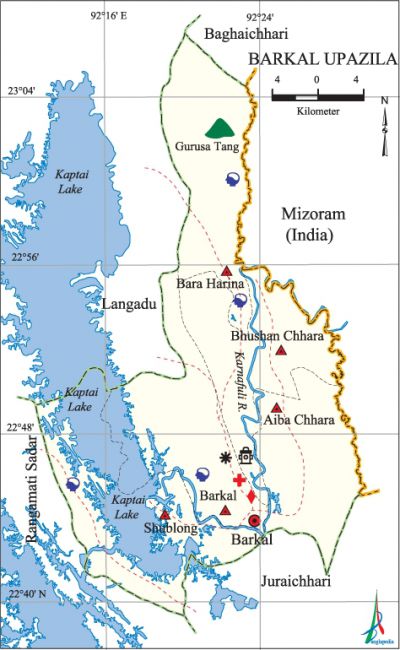Barkal Upazila
Barkal Upazila (rangamati district) area 760.89 sq km, located in between 23°39' and 23°14' north latitudes and in between 92°11' and 92°29' east longitudes. It is bounded by baghaichhari and langadu upazilas on the north, juraichhari upazila on the south, Mizoram (India) on the east and Langadu and rangamati sadar upazilas on the west.
Population Total 47523; male 25614, female 21909; Muslim 11023, Hindu 508, Buddhist 35668, Christian 318 and others 6.
Water bodies Main river: karnafuli; kaptai lake is notable.'
Administration Barkal Thana was formed in 1923 and it was turned into an upazila in 1985.
| Upazila | ||||||||
| Municipality | Union | Mouza | Village | Population | Density (per sq km) | Literacy rate (%) | ||
| Urban | Rural | Urban | Rural | |||||
| - | 5 | 28 | 180 | 1932 | 45591 | 62 | 72.6 | 43.2 |
| Upazila Town | ||||||||
|
Area (sq km) |
Mouza |
Population |
Density |
Literacy rate (%) | ||||
| 12.95 | 1 | 1932 | 149 | 72.6 | ||||
| Union | ||||
| Name of union and GO code | Area (acre) | Population | Literacy rate (%) | |
| Male | Female | |||
| Aiba Chhara 15 | 34420 | 4269 | 3891 | 32.5 |
| Bara Harina 31 | 39680 | 2544 | 2395 | 35.8 |
| Barkal 47 | 33920 | 3661 | 2881 | 56.1 |
| Bhushan Chhara 63 | 49280 | 8939 | 7215 | 45.1 |
| Shublong 79 | 30720 | 6201 | 5527 | 48.6 |
Source Bangladesh Population Census 2011, Bangladesh Bureau of Statistics.

Historical events The atrocities of the Kukis increased in this region during the early part of the British rule in India. The British Government established separate district administration to control the Kukis in 1860. The government launched an extensive operation in 1872 from Tripura, Kachhar and chittagong hill tracts and destroyed the Kukis’ hideouts in Lusai or Mizoram region. In 1891 and 1893 the final campaign for elimination of the Kukis were executed.
War of Liberation Pakistani army had established their camps at Subalong, Barkal Sadar, Zaliapara and some other places of the Barkal upazila at the beginning of the War of Liberation. The freedom fighters could not create strong resistance against them but they carried out a number of small operations. Freedom fighters however, organized a severe attack on the Pakistani soldiers at Zaluipara in November, in which 35 enemy soldiers were killed. Barkal upazila was liberated from the enemies on 14 December 1971.
For details: see বরকল উপজেলা, বাংলাদেশ মুক্তিযুদ্ধ জ্ঞানকোষ (Encyclopedia of Bangladesh War of Liberation), বাংলাদেশ এশিয়াটিক সোসাইটি, ঢাকা ২০২০, খণ্ড ৬।
Religious institutions Mosque 7, temple 7, buddhist temple 29, church 3.
Literacy rate and educational institutions Average literacy 44.5%; male 54.2%, female 33.0%. Noted educational institutions: Barkal High School, Bilchhara High School, Bhaimithai Primary School, Laijugram Primary School, Dhanubag Primary School.
Tourist spots Shublong waterfall.
Main sources of income Agriculture 83.46%, non-agricultural labourer 2.19%, commerce 5.87%, service 2.54%, construction 0.08%, religious service 0.07%, rent and remittance 0.03% and others 5.76%.
Ownership of agricultural land Landowner 66.31%, landless 33.69%; agricultural landowner: urban 48.85% and rural 66.86%.
Main crops Paddy, cotton, sesame, ginger, turmeric, vegetables.
Main fruits Jackfruit, banana, pineapple, watermelon.
Fisheries, dairies and poultries This upazila has a number of fisheries, dairies and poultries.'
Communication facilities Semi-pucca road 5 km, mud road 436 km; waterway 50 km.
Manufactories Steel mill.
Cottage industries Blacksmith, weaving, bamboo work, cane work, wood work.
Hats, bazars and fairs Shublong Bazar, Choto Harina Bazar and Barkal Bazar.
Main exports Banana, wood, bamboo, cotton, sesame.
Access to electricity All the unions of the upazila are under rural electrification net-work. However 27.7% dwellings have access to electricity.
Sources of drinking water Tube-well 9.9%, tap 0.8% and others 89.3%.
Sanitation 17.7% of dwelling households of the upazila use sanitary latrines and 78.0% of dwelling houses use non-sanitary latrines; 4.3% of households do not have latrine facilities.
Health centres Hospital 1, Upazila health complex 1.
NGO activities Junopahar. [Atikur Rahman]
References Bangladesh Population Census 2001 and 2011, Bangladesh Bureau of Statistics; Cultural survey report of Barkal Upazila 2007.
